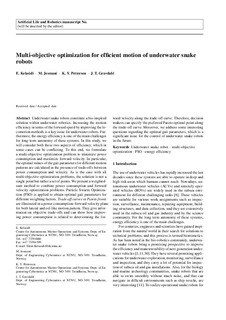| dc.contributor.author | Kelasidi, Eleni | |
| dc.contributor.author | Jesmani, Mansoureh | |
| dc.contributor.author | Pettersen, Kristin Ytterstad | |
| dc.contributor.author | Gravdahl, Jan Tommy | |
| dc.date.accessioned | 2016-11-07T10:58:08Z | |
| dc.date.accessioned | 2016-11-14T13:41:03Z | |
| dc.date.available | 2016-11-07T10:58:08Z | |
| dc.date.available | 2016-11-14T13:41:03Z | |
| dc.date.issued | 2016 | |
| dc.identifier.citation | Artificial Life and Robotics 2016, 21(4):1-12 | nb_NO |
| dc.identifier.issn | 1614-7456 | |
| dc.identifier.uri | http://hdl.handle.net/11250/2420868 | |
| dc.description.abstract | Underwater snake robots constitute a bio-inspired solution within underwater robotics. Increasing the motion efficiency in terms of the forward speed by improving the locomotion methods is a key issue for underwater robots. Furthermore, the energy efficiency is one of the main challenges for long-term autonomy of these systems. In this study, we will consider both these two aspects of efficiency, which in some cases can be conflicting. To this end, we formulate a multi-objective optimization problem to minimize power consumption and maximize forward velocity. In particular, the optimal values of the gait parameters for different motion patterns are calculated in the presence of trade-offs between power consumption and velocity. As is the case with all multi-objective optimization problems, the solution is not a single point but rather a set of points. We present a weighted-sum method to combine power consumption and forward velocity optimization problems. Particle Swarm Optimization (PSO) is applied to obtain optimal gait parameters for different weighting factors. Trade-off curves or Pareto fronts are illustrated in a power consumption--forward velocity plane for both lateral and eel-like motion pattern. They give information on objective trade-offs and can show how improving power consumption is related to deteriorating the forward velocity along the trade-off curve. Therefore, decision makers can specify the preferred Pareto optimal point along the trade-off curve. Moreover, we address some interesting questions regarding the optimal gait parameters, which is a significant issue for the control of underwater snake robots in the future. | nb_NO |
| dc.language.iso | eng | nb_NO |
| dc.publisher | Springer | nb_NO |
| dc.title | Multi-objective optimization for efficient motion of underwater snake robots | nb_NO |
| dc.type | Journal article | nb_NO |
| dc.type | Peer reviewed | nb_NO |
| dc.date.updated | 2016-11-07T10:58:08Z | |
| dc.source.pagenumber | 1-12 | nb_NO |
| dc.identifier.doi | 10.1007/s10015-016-0332-3 | |
| dc.identifier.cristin | 1397969 | |
| dc.description.localcode | he final publication is available at Springer via http://dx.doi.org/10.1007/s10015-016-0332-3 | nb_NO |
